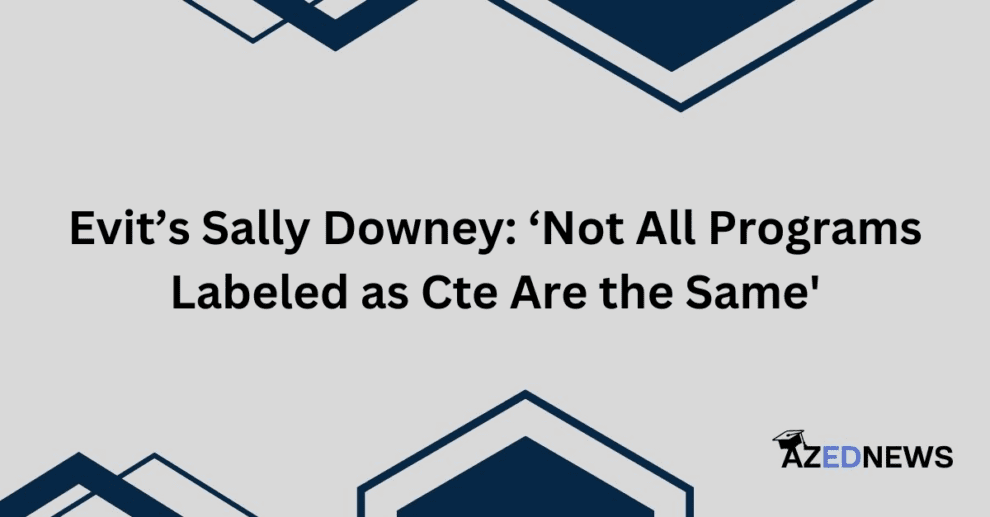Career and technical education is getting a lot of attention these days in national media – and for good reason, said Dr. Sally Downey, superintendent of the East Valley Institute of Technology.
Research shows that students who complete quality CTE training, such as EVIT’s cosmetology, radio broadcasting or aviation programs, are more likely than other students to be engaged in learning and successful in school and career, Downey said.
Dr. Sally Downey, superintendent of the East Valley Institute of Technology
“For instance, students who attend the East Valley Institute of Technology have a 95 percent high school graduation rate – 20 percentage points higher than Arizona’s grad rate of 75 percent – and two out of three go on to college,” Downey said. “Within one year of completing their CTE programs, 86 percent of EVIT students are in jobs, college or the military.”
Q: How has career and technical education changed over the years?
A: Years ago, when career and technical education was called “vocational education” and EVIT was called Mesa Vo-Tech, it was viewed as an alternative for students who didn’t have the academic skills to go to college. But that’s not the case anymore.
Today, quality career and technical education and EVIT are proving to be a better prep for success than traditional college prep in meeting the needs of all students – whether they are merit scholars or students with special needs or those who learn best through hands-on instruction.
In the mid-1990s, 10 East Valley school districts joined together to start EVIT, Arizona’s first Joint Technological Education District (JTED), to provide the high quality career training that was too costly for each district to provide on its own.
After approval by the Legislature and voters, Mesa Vo-Tech was transformed into EVIT, a centralized Mesa campus that would, in partnership with business and industry, provide CTE for students in those districts. The students would take their career training at EVIT and their academic classes at their home high school.
Then several years after EVIT opened, legislators amended the JTED law to allow for satellite programs in district high schools, as well as central campuses. So today, EVIT programs are offered at three centralized campuses, while districts in the EVIT JTED also offer satellite programs at their high schools.
Q: What should families find out before enrolling their child in a career and technical education program?
Students in the East Valley Institute of Technology’s Fire Science program not only learn through hands-on experience, but also have the opportunity to earn up to 15 hours of college credit through EVIT’s dual enrollment partnership with Mesa Community College. They also test for numerous industry credentials, including a national certification in Aircraft Rescue and Firefighting. Photo courtesy of EVIT
A: Not all programs labeled as CTE are the same. As with any education decision, students and parents need to ask questions before enrolling in a CTE program.
Some questions to ask, include:
• What are the credentials and experience of the instructor?
For instance, if your son or daughter is taking culinary arts or automotive or welding, ask if the teacher has ever worked in those industries.
• Is the class certified by a professional credentialing body, such as the American Welding Society?
• Will the training prepare your child to test for a state or national license, such as Certified Nursing Assistant (CNA)?
• If it’s a high school program, is dual enrollment college credit offered?
• Are business and industry actively involved in determining the program’s curriculum?
Quality CTE trains students in the skills necessary to earn a professional, industry-recognized credential or college credit or both.
Q: What else will a quality career and technical education program help students develop?
EVIT’s Welding Technologies program has been certified by the American Welding Society as a testing site for the highest industry credential a welder can obtain. Welding students can also earn up to 15 hours of dual enrollment college credit through Central Arizona College. Photo courtesy of EVIT
A: It provides opportunities for hands-on, real-world experience in the form of job shadowing or internships.
It teaches students the so-called “soft skills,” such as being able to communicate effectively, that employers say are all too often missing in today’s job candidates.
And it accomplishes all this because the program works closely with business and industry to ensure that students are being trained to meet current industry standards.
In short, by the time a student completes a CTE program, he or she should be ready to go into the workforce.
It might be the job they’ve chosen as their career, or it might be an entry-level position to make money while going to college in a related field.
For instance, many students in EVIT’s School of Health Sciences start off their careers as medical, dental, nursing or veterinary assistants – while going to college to become registered nurses, dental hygienists, vet techs, or even dentists, veterinarians or doctors.
Q: What does the future hold for career and technical education?
EVIT’s Culinary Arts and Commercial Baking programs are the only high school culinary programs in Arizona that are accredited by the American Culinary Federation Education Foundation. This allows EVIT students to test for national certification as a Junior Culinarian and Secondary Culinary Graduate. EVIT students can also earn up to 16 hours of dual enrollment college credit through Scottsdale Community College and up to nine credit hours through Central Arizona College. Photo courtesy of EVIT
A: It’s an exciting time in career and technical education because it’s finally getting the credit it deserves for providing young people with relevant learning and a path to both college and career.
President Obama recently acknowledged the benefits of quality CTE, and Gov. Doug Ducey has repeatedly expressed his support of EVIT and recognition that quality CTE can lead to improved education outcomes and workforce development in Arizona.
But that word “quality” is key – and that’s why I keep saying it – because CTE programs are only as good as the expertise, effort and expectations that are put into them.
For more on career and technical education in Arizona, please read AZEdNews’ special report:
Part 1: Can AZ lead in career and technical education despite millions in cuts?
Part 2: AZ budget cuts reduce career and technical education funding by 53 percent
Part 3: What’s next for AZ career and technical education?











